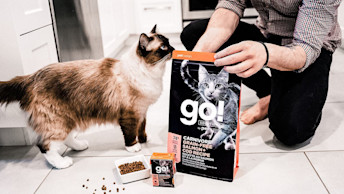May 31, 2021
How Do I Feed My Picky Cat?

Felines and fussiness are nearly one in the same. The majority of cat owners have had some dilemma when it comes to their beloved kitty turning their nose up from food at one time or another. Having issues feeding a picky cat seems almost to be a natural occurrence. However, most cat experts will tell you that picky eaters are made, not born. In an attempt to please them, we can accidentally create cats who become little food critics. Here are our top tips on how to feed a picky cat.
Diet Facts for Picky Cats
When it comes to cats, there are some interesting facts to consider about their diet. Firstly, many cats experience neophobia, which is an aversion to new or unfamiliar foods. Most cats are picky eaters and aren't happy with the sudden change in their environment - especially when it comes to changing their food.
Secondly, in comparison to dogs, cats have some unique dietary requirements. Cats have evolved from their strictly carnivorous beginnings when prey consumption was their staple for survival. Today, cats live a different type of life and can thrive on a variety of diets.
From a nutrient perspective, cats don't necessarily require an ultra-high protein diet, but they do have higher requirements for amino acids from dietary protein than dogs.
Create a Designated Feeding Area
When it comes to the location of where you place your cat's food, it's essential to note that cats need to have their food and water dish away from the litter box. Cats have a strong desire to keep their eating area away from the site where they eliminate. Cats are naturally very clean creatures, and if you place the two near each other, they may nibble on their food but refuse to use the litter box or use their litter box and refuse to eat.
Unlike us, cats aren’t social eaters. They don't enjoy group dining in crowded areas. Place food in a quiet space, away from the busy areas of the house. If you have a multi-cat home, give each cat its own feeding station. In households with small children or dogs, an elevated eating area will be your best bet. Not only does it keep the others out of the cat's food dish, but it also gives your cat a sense of security.
Say No to Additives
When it comes to hiding medication in your cat's food - it's best to avoid this trick. Their keen sense of smell can detect any foreign substance that does not belong. Some medications are very bitter, and even if it gets past your cat's nose, they will taste it. They might associate their food with a bad taste, even after you stop putting medication in it.
Additionally, adding "treats" (fish, chicken or other meat) to food is another recipe for disaster. Doing this will raise your cat's flavour expectations, and when you try to feed the food on its own, they may refuse it. Just as it is with dogs, it is best to keep food scraps away from your cat.
Mix Up the Variety of Recipes
Cats are sensitive to the shape, size, mouthfeel, and texture of the foods they eat, so it's best to start them early with a wide variety of recipes. There are many reasons why cats can become picky eaters. However, adjusting the way we feed our cats can help prevent most of these issues. If your cat stops eating at any time, a visit to the vet is always a good idea. Cats will stop eating if they are ill, and it does not take long for them to go into fatty liver failure, which can be fatal.
Moreover, many cat owners find food that their cat enjoys and then feed it to them day after day, sometimes for years. If the formula of the food changes, or if the cat needs to go on a special diet, you may find yourself with a cat who refuses to eat. Therefore, vets and cat experts suggest that you vary your cat's diet to avoid this.
Tip: Try adding in something with unique and delicious flavours like the Go! Solutions Carnivore Grain Free Turkey, Chicken + Duck Recipe. Packed with delicious fresh meats and probiotics, this kibble is perfect for picky eaters.
Food Tips for Feeding a Picky Cat
- Feed your cat both dry and wet food. In the case of dry, provide two to three small portions daily as opposed to free feeding - this keeps the food fresh.
- Feed wet food to ensure hydration, as many cats do not recognize when they are thirsty or drink enough at the water bowl.
- Try changing the flavour, texture, and shape of your cat’s food. Recipes like Go! Solutions Carnivore Grain-Free Minced Lamb + Wild Boar offer both delicious flavours and high moisture content.
- If you are making any significant food changes, ensure it's done gradually to avoid stomach upset or food rejection.
- If you’re getting a new kitten, consider feeding a wide variety of textures and flavours. This can help avoid pickiness later on in life.
Remember, feeding a picky cat can be a challenge at first. But, with patience, trial and error, and by implementing some of our tips, you will be able to find recipes and solutions that work for both you, and your cat.



